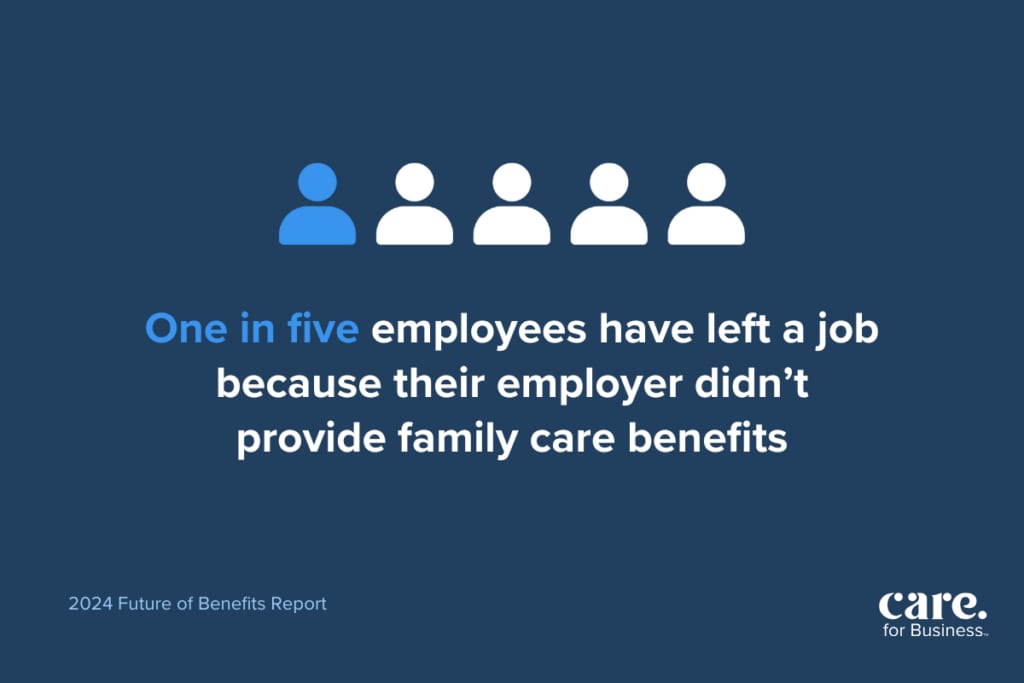Right now, your employees are coordinating doctor’s appointments between meetings, checking in on aging parents during lunch breaks, and racing from daycare to the office. In other words, your top performers, your emerging leaders, and your knowledgeable veterans are quietly making hard choices between career growth and caregiving responsibilities.
Caregiving challenges aren’t limited to a small subset of your workforce. Nearly three in four U.S. workers (73%) have caregiving responsibilities woven into their daily reality, with 76% spending 10+ hours per week caring for children, seniors, special needs children and adults, or pets.
Creating an environment where employees can thrive starts with a culture that recognizes and embraces caregiving as a central part of employees’ lives. With a culture of care as the foundation, both employees and organizations are set up for success.
The business case for a care culture
The daily juggle of work and caregiving responsibilities takes a measurable toll on employee performance. Among full-time employees who are family caregivers, 62% rank the stress of managing their job and caregiving as their first or second biggest challenge. As employees struggle to balance competing demands, their focus and effectiveness at work inevitably suffer.
The business impact extends beyond performance and productivity. Caregiving takes a significant toll on overall employee well-being. Just one in four caregivers report good physical health, with only one in five saying they eat well and exercise regularly and only one-third keeping up with routine medical care.
The mental health impact is equally striking. Only 23% of caregivers rate their mental health as “good,” and they are 62% more likely than non-caregivers to experience anxiety, depression, or other mental health challenges. When caregivers’ physical and mental health suffers, businesses face rising healthcare costs and increased absences.
Access to family care benefits is a key consideration as employees decide to stay in their jobs or seek a new opportunity. Our 4th Annual Future of Benefits Report found that one in five employees have left a job because their employer didn’t provide family care benefits, and 70% of working parents are more likely to choose an employer that provides child care benefits over one that does not.
The business costs related to talent acquisition and retention add up. U.S. companies lose an estimated $23 billion each year in revenue and hiring costs related to insufficient child care support, with lost income due to all family caregiving responsibilities totaling $522 billion annually.
The business impact of care benefits is clear. More employers recognize the value that family care benefits play in creating a culture of care. 82% of employers say that child care benefits positively impact employee productivity, while 78% connect productivity gains to senior care benefits. As a result, 56% of companies say they prioritized child care benefits in 2024, a 10% increase over 2023. In addition, 50% reported increased prioritization of senior care benefits.

The building blocks of caregiver support
A caregiver-friendly workplace culture is built on several foundational elements that work together to create a supportive environment for employee caregivers. Understanding the different components helps organizations envision what’s possible.
At the core, a care culture is based on normalizing caregiving beyond child care, such as caring for aging parents, family members with special needs, and even pets. Recognizing that caregiving responsibilities are a universal part of employees’ lives, the stigma around discussing care needs diminishes. Normalizing caregiving also includes encouraging self-care as an important way employees can alleviate stress and prevent burnout.
Workday flexibility demonstrates a company’s commitment to caregiver support. This flexibility must be based on the recognition that caregiving doesn’t follow a fixed schedule. By giving employees options to adjust when and where they work as they deal with caregiving challenges, organizations acknowledge that job performance and caregiving responsibilities aren’t mutually exclusive. This support can take the form of early starts, split shifts, or the ability to step away for care needs and return to work later. True flexibility also extends beyond daily schedules to include longer-term arrangements, such as paid leave, when more intensive caregiving needs arise.
Care benefits are another crucial building block in a care culture. Child care support is the first thing many people think of, but it’s just one piece of the caregiving puzzle. Care benefits through the workplace can address a broad range of family care needs, such as:
- Access to a network of caregivers to reduce the time-consuming burden of searching for and coordinating care. Whether employees need backup child care coverage during school breaks, a trusted pet sitter, or support for an aging parent, having a pre-screened network of providers offers both convenience and peace of mind.
- Expert, personalized guidance helps employees navigate care decisions, assisting with everything from daily child care to specialized support for seniors and family members with disabilities or neurodiversity needs. By sharing the load of care coordination, care specialists save employees time, help them find the right solutions, and enable them to stay focused on work when they’re at work.
- Care spending accounts help alleviate the financial stress and pressures of planned and unexpected caregiving expenses. Employers choose the dollar amounts to provide through the accounts and the types of care that are covered.

How to build a culture of care
With the building blocks of caregiver support in place, organizations can take seven steps to create or strengthen their care culture.
- Start with fact-finding. Survey your workforce to understand their caregiving needs and analyze benefits utilization patterns to identify opportunities to enhance caregiving support.
- Make caregiving part of the conversation. Your goal is to create psychological safety that enables employees to feel comfortable discussing their caregiving challenges. One effective way to open the conversation is for leaders to talk about their caregiving experiences and how they navigate them.
- Equip frontline managers with tools and training to open the door to conversations about caregiving responsibilities. When managers understand the realities of their employees’ caregiving challenges, they’re better positioned to support their teams, identify signs of caregiver burnout, and balance team productivity with flexible support.
- Create peer networks for added support. Establish Employee Resource Groups (ERGs) to provide communities where caregivers can find connection, understanding, and solutions. Most importantly, ERG resources remind employee caregivers that they’re not alone.
- Enhance care benefits strategically. Use the insights gleaned through fact-finding and ongoing conversations to bring together the right set of family care benefits to match your employees’ specific care needs.
- Communicate, communicate, communicate. Keep caregiving needs and benefits top of mind by making them a staple message across all available employee communication channels, both formal and informal.
- Track progress and adjust. Monitor metrics like benefits utilization, employee feedback, and retention rates to ensure your support continues to align with workforce needs. Regular strategy check-ins enable organizations to respond quickly to changing needs.
For more insights about building a culture of care and care benefit solutions for your employees, get in touch with us today.




